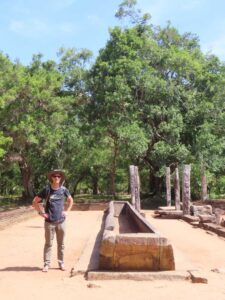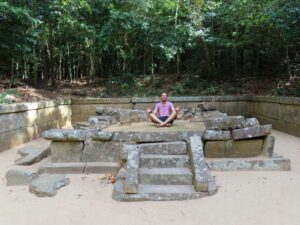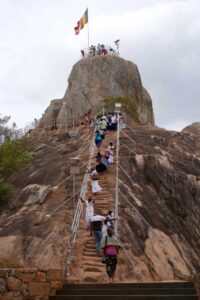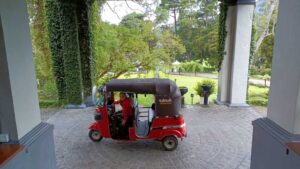Hot-footing it through Sri Lanka
Now, where did we go in Sri Lanka with Tiktok our tuktuk….
There are so many amazing places to visit we couldn’t see them all, but we certainly tried to see as many as we could in five weeks. We of course asked Jerome for some tips, as well as Jo and Michael (thanks all!), and checked websites and guide books for inspiration. We hadn’t been able to buy a guide book of Sri Lanka yet, but as we arrived in Colombo we were super lucky to find a Bradt guide about Sri Lanka on the first day in our accommodation, and a Lonely Planet Sri Lanka when we picked up the tuktuk the next day. Perfect.
As it was low season in Sri Lanka it was not hard to find accommodation. So, whilst we knew where we wanted to go, we often decided to change our plans and extend our stay in places we enjoyed. Because of our tuktuk we were completely flexible and usually only booked our next guesthouse last minute.
Of course we visited the ancient ruins dotted across the country. Tiktok the tuktuk made it easy to get to all of them.
Anaradhapura was the first area with ruins we visited. It has been inhabited for more than 3,000 years and was once the capital of Sri Lanka. It is now the site of the oldest living (planted) tree in the world and you can find many Buddhist temples here. We left Tiktok at our guesthouse and used their bikes to get around. We could ride between the ancient ruins, park our bike, explore and then hop on again to the next one. They are quite spread out so having some transport is key. In Polonnaruwa we decided to use the tuktuk to drive from one ruin to the next temple as it was very, very hot again. The ancient Buddhist ruins here mostly date back to the 12th century. This too was once the capital of Sri Lanka, and it is also a World Heritage Site. We had decided to start early and that was a good choice. Taking off your shoes to walk around religious sites is normally not an issue, but with the burning sun the grey stones become too hot to walk on. Going early meant we had the place to ourselves and it was still possible to walk around comfortably.
In Sigiriya we found the ruins of a palace built on top of a huge rock. Complete with gardens and a pool. The name Sigirya means Lion Rock, because the king built an entrance gate in the shape of a giant lion about halfway up the rock. He also decorated the rock with amazing frescoes of ladies. They are stunning, and there used to be 500 of these. The best time to visit the top of the rock is again in the early morning. Whilst you don’t need to remove your shoes here, the stairs to the top are very exposed and narrow, so traffic jams form and people stand in the baking sun for hours just trying to get to the top later in the day. We enjoyed a lovely sunrise walk up and had breakfast amongst the palace ruins. Keeping a keen eye out for any monkeys who might want to steal our food.
Our favourite ancient site was probably the little visited Ritigale ruins where you walk around in the forest surrounded by bird sounds and wildlife, just like the monks did all those years ago. The buildings from the monastery date back to the first century BC. Incredible.
We also explored Mihintale as well as the Dambula caves. Mihintale is a Buddhist pilgrim site on a mountain peak with ruins and lots of monkeys scattered around. At all the temples and pilgrimage sites we visited, the monkeys enjoy a choice diet of fresh offerings of beautiful flowers. You can buy the flowers at any road stall approaching a temple, and within minutes (seconds!) of offering the flowers, the monkeys are all over them, often only eating the flower petals or even just the centre of the flower. They make a right royal mess of the beautiful offerings in the process too, but nobody seems to mind. The Dambula caves were very impressive with many statues and frescoes on the walls and ceilings. we really enjoyed them. Maybe we also relished the coolness of the caves? It was super hot when we were in Sri Lanka.
In Kandy we were lucky to be there at the time of the Randoli Perahera (procession). This annual 10-day festival is to pay homage to the sacred tooth from Buddha, which is enshrined at the Temple of the Tooth, and is one of the biggest religious festivals in Sri Lanka. The parade starts with whip-crackers and fire acrobats, followed by Buddhist flag bearers. There are a lot of dancing groups and musicians, all surrounded by torch bearers and it is beautiful to watch. But unfortunately they still use elephants to participate during the procession too. We counted more than 50 of them, and whilst it may seem important to uphold ancient traditions, we personally felt it is time to retire the elephants and stop carting them around the country from temple to temple for these religious processions.

elephants are still being used today as part of the procession during the religious festivals – we counted more than 50
We didn’t do much beach holidaying, but we did spend a few leisurely days in Nilaveli and popped into Trincomalee whilst we were there. We hiked up Adam’s Peak which we loved because there were no crowds. Six months of the year it is closed for pilgrims to allow nature to ‘rest’. It means the temple at the top is not open, but as a foreigner you can still hike to the top. When the pilgrims are there it is chaos apparently with people taking 10 hours to get to the top due to traffic jams on the last narrow section. Most tourists start at 2am and try to get to the top for sunrise. We didn’t. We started at 8am and enjoyed the views and the wildlife. There isn’t really anywhere to sit at the top to watch sunrise, so we were glad we did it our way.
Sri Lanka is of course also famous for its tea, and we saw many, many tea plantations. We even took the train from Nuwara Eliya to Ella (and back the next day), cruising at 10-15km per hour on rickety old train tracks through the country side covered in tea plants with ladies picking the tea leaves. Nuwara Eliya is in the coolest area of Sri Lanka, a welcome relief for us from the heat. We indulged in an afternoon of high tea in Nuwara Eliya, and visited a small tea plantation near Galle. We tried their 40 different types of teas after a short tour of the grounds and the machinery, including the famous white tea that is picked and processed here without any human hands ever touching the leaves (or so they claim).
A trip to Sri Lanka wouldn’t be complete without watching the famous fisherman sit on their stilts in the ocean. Nowadays this is just done for tourists (or so it appears) and we continued on to Galle after just a two minute stop.

fisherman sit on the stilts in the ocean, nowadays they seem to be there to collect money from tourists who want to take a picture
Galle is another world heritage site. The town has the largest remaining fortress in Asia that was built by Europeans (built by the Portuguese and fortified by the Dutch). We wandered its narrow streets, found the best bakery in the country (selling dark wholemeal bread and sandwiches) and admired the skills needed to get kites into the skies with tails that are more than 100m long. We spoke to one group of guys whose kite had a tail of 150m. It takes a whole team often several attempts to get it airborne. It was really cool to watch all the kites jostling for space above the old fort.
Jude also found a random ayurvedic clinic inside the fort where she went to get a treatment for her back. Dr Gathmini, the volunteer doctor that happened to be seeing patients that day was amazing, so she went back a few more times.
Besides all the historical and religious sites, Sri Lanka also has many national parks and we visited several of them. A trip to Sri Lanka isn’t complete without them. If you want to read about our experience in the national parks and about Sri Lanka’s wildlife, you will have to wait til the next episode! We had so many amazing wildlife adventures, we decided to dedicate a whole separate blog to it. You might be just as surprised as we were about the wildlife there!

























